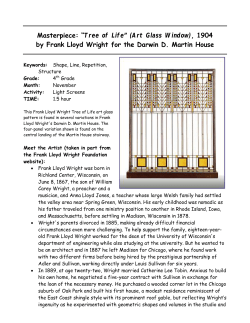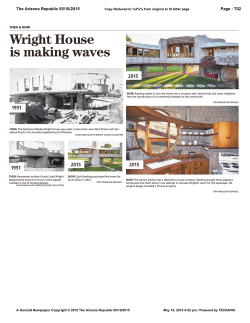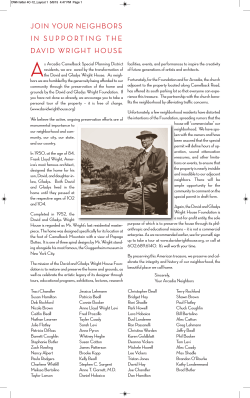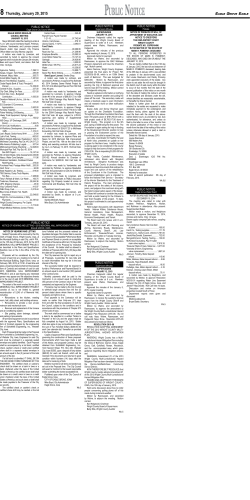
Document 69282
left his Oak Park, Illinois, studio in 1909, ending his Prairie house period. Between World War I and the mid-1930s, Wright executed comparatively few commissions - the most notable being Tokyo’s Imperial Hotel and his series of textile block houses in California - but this second period was full of experimentation with different building techniques and new designs based on geometric forms other than the square or rectangle. He wrote An Autobiography in 1932, a book that inspired many young architects and artists to join his newly-formed Taliesin Fellowship, an institute devoted to artistic endeavor. The Fellowship was (and continues to be) based at his homes in Spring Green, Wisconsin (Taliesin) and Scottsdale, Arizona (Taliesin West). Wright emerged from this period with several large projects that captured the public imagination, including Fallingwater, which appeared on the cover of Time magazine in 1938. At the same time, he developed the Usonian house, designed for families of modest income. The Usonians were generally single-story houses with simple floor plans, based on a grid system, with radiant heat, a small, central kitchen space, and usually flat roofs. For the rest of his career, he continued to devote his attention to residential design – both luxurious and spare – with a remarkable variety of form. The soil that sprouted Frank Lloyd Wright was the rural Wisconsin countryside. Throughout his life Wright spoke of the influence of nature on his work and attributed his love of nature to those early years in the rural Wisconsin countryside. During summers spent on his uncle’s farm he learned to look at the patterns and rhythms found in nature – the branch of a tree (a natural cantilever), outcroppings of limestone, and the ever-changing sandbars. Wright later advised his apprentices to “study nature, love nature, stay close to nature. It will never fail you.” The influence of nature is apparent in his work. From the earth-hugging “prairie” houses such as the Robie House in Illinois and Taliesin in Wisconsin, to the cascading cantilevers of the 1936 Fallingwater, from the sky-lighted forest of concrete columns of the 1936 Johnson Wax Administration Building in Wisconsin, the rugged beauty of Taliesin West in Arizona, to the spiraling, “snail-like” Guggenheim Museum completed in 1959 in New York City, his work shows a command of nature and native materials and an instinctive understanding of social and human needs. No other architect so intuitively designed to human scale. No other architecture took greater advantage of setting and environment. No other architect glorified the sense of “shelter” as did Frank Lloyd Wright. “A building is not just a place to be. It is a way to be, “he said. From the Frank Lloyd Wright Foundation website A Romance with Nature Frank Lloyd Wright’s love affair with the natural world began when he was a child growing up on land settled by his Welsh ancestors near the Wisconsin River. There nature was spread out for the hungry young Wright like a feast to be devoured. Wooded hills surrounded open fields, which were cut through by streams that coursed off into a broad river valley edged with rock bluffs worn away by the forces of water and weather. like Thoreau, Wright valued the wildness of the American landscape and mourned civilization’s incursions. The influence of nineteenth-century American writers in addition to childhood days spent roaming his small but fertile world left an imprimatur on Wright that resonated in every building he created. As a boy of eleven working on his family’s farm, Wright gained an experiential understanding of nature’s forms and processes. In his autobiography he recalled learning about the woods while searching for lost cows and discovering the plasticity of mud oozing between his toes as he walked barefoot in the garden. He studied light, noting its different characteristics at dawn and at dusk. He observed the blue of night shadows and the way in which the sun filtered through the leaves of trees, dappling light on the ground beneath. He also recognized nature’s duality, its unrestrained, seemingly chaotic power in contrast to its subtle, ordered beauty. And he came to understand that it is the dichotomy in nature, which accounts for its richness. Wright’s youthful observations were confirmed and further developed as he read the works of Walt Whitman, Ralph Waldo Emerson, and Henry David Thoreau. From Whitman, Wright formed the conviction that a close relationship with the landscape was an American birthright. He believed his architecture, rooted in a deep understanding and appreciation of nature, would be the first truly American architecture. Emerson’s assertion that the beautiful and the useful should never be separated from one another became a guiding principle for Wright. And As a child and young man, Frank Lloyd Wright watched the Midwestern prairies disappear, as well as the Indians and the western frontier. The 1890 US Census declared the frontier closed, and in 1893, the historian Frederick Jackson Turner spoke eloquently of frontier life. The frontier, he said, had nurtured the intellectual traits typical of the expansive American character: individualism, restless energy, the buoyancy and exuberance associated with freedom. Wright saw himself as an American pioneer, and tried to keep the frontier spirit of freedom alive through his buildings. Low, spreading roofs, open plan interior spaces, entire walls open to glass – all combine to create an expansive architecture that Wright felt was truly American. From Fallingwater: Frank Lloyd Wright’s Romance with Nature
© Copyright 2024





















